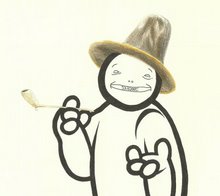✪ On grazing hermits.
On one of my explorations through hagiographic literature in the Central Library of Amsterdam, I came across a text which just mentioned a piece of very very odd behavior.
When Christianity was legalized by Roman Emperor Constantine, the Christian Saints were no longer prosecuted. To prove their dedication to faith they found a new way to suffer, Asceticism.
Soon this practice got really out off hand and people would come up with ever less comfortable ways of existence. Starving and suffering, they could go for hours, or even days without the normal signs of life.
Dead to the world they lived in God. Saints became like athletes of Christ and in this passage I read the most stunning account yet, that there were even hermits who grazed like sheep. The golden age of grazers was the 6th century, when people ate grass all their lives at the coasts of the Red Sea.
Further research has shown these Bosci or Boskoi to be either animal-like in behaviour or to be nomadic people living of grass they foraged using sickles. The most fantastic account comes from a chapter called 'The Mental Condition of Hermits', in 'A History of the Intellectual Development of Europe', by John William Draper.
'If they were not recorded by many truthful authors, the extravagancies of some of these enthusiasts would pass belief. Men and women ran naked upon all fours, associating themselves with the beasts of the field. In the spring season, when the grass is tender, the grazing hermits of Mesopotamia went forth to the plains, sharing with the cattle their filth and their food.'
More on: Libarynth
























































